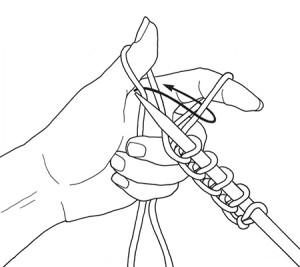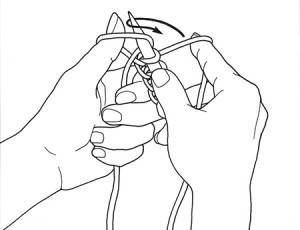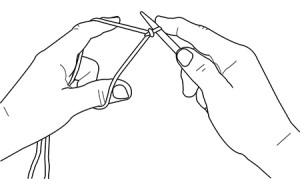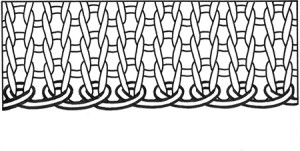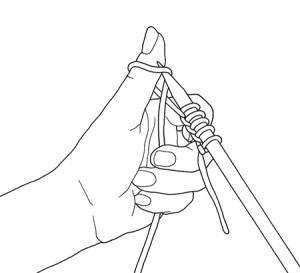About Those Names
After the second edition of The Principles of Knitting was published in February 2012, I became aware that some knitters were unhappy because the terms I used for various techniques were not familiar to them; they wanted to know why I renamed everything.
First, it’s important to understand that the names in both editions of the book are the same, so all the “renaming” was done some thirty years ago when I wrote the first edition of The Principles of Knitting. Nevertheless, these terms will be new to knitters who have never seen that book, so a little background on my thinking at the time might help make it clear why I used the names I did.
In the early 1980s, when I began writing my book, I started to acquire a library of other knitting technique books as a basis for my research (there are over 200 of them in the bibliography of the new edition, but there are many more on my bookshelves).
The oldest books reflect the regional traditions familiar to the author or publisher and were meant for an audience that shared them. Some basic instructions were often provided, and they might include, for instance, two or three cast ons, more often than not called Method One, Method Two, and maybe Method Three. As published knitting patterns became more popular, techniques were sometimes given names, but those used in one area differed from those in another, or the same name might be applied to a different technique.
It didn’t take long for me to realize there were far more than three cast on techniques and I was going to need better names for them. When there were several names for the same technique, it seemed quite arbitrary to choose one instead of another. It would have been impractical to adopt a numeric system because you would now be faced with trying to remember how to do Cast-On Method Fourteen, or Twenty-Four. Also, a name was often derived from how something was done, but many techniques are made in a similar way, even when the resulting edge is different, so that approach didn’t work very well, either.
What I finally settled upon was a preference for names that indicated the structure and/or appearance of the fabric that resulted from using a technique. This worked very well when I needed a name for something that had never had one before, or for a new technique that I developed. Occasionally I retained a traditional name because it did not seem to be called anything else, and it fit with my system reasonably well. However, from time to time I found it necessary to change a name, either because the one it had could be confused with another, or because it didn’t convey anything about the result.
Of course, I hoped that knitters would find the terms I adopted as helpful as I did. Unfortunately, the first edition of The Principles of Knitting was out of print for nearly 15 years and during that time, major knitting events brought thousands of knitters together for classes and the internet connected them wherever they lived. As a result, names I had not used for a technique, or had never encountered when I was writing the first edition, became more common.
While I was aware that this was taking place when I began working on the second edition in 2000, I decided to use the same names as before. Partly I wanted to be consistent for the sake of knitters who valued the first edition, but even more important was that my reasons for choosing them in the first place were still valid.
For those of you who have found some of these names confusing, or who are simply curious about my thinking, here is an explanation of how I came to name two common techniques that are now more often called something else.
Knit Half-Hitch Cast-On = Long Tail Cast-On
The Compound Cast-Ons are a large family of closely related techniques, and they are the first ones in the chapter that use a “tail” of yarn (a length measured from the free end of the yarn to where it is attached to the needle).
I call them Compound Cast-Ons because they employ two strands of yarn, one for the edge, the other for the first row of stitches. By far the most important member of this family is Knit Half-Hitch Cast-On, which is what many people now call Long Tail Cast-On. However, when I began writing the book, that particular name was rarely used for the technique and, in fact, it is still known by several others.
There are two different ways to hold the yarns when doing this cast on — both yarns in the left hand, or one yarn in each hand; they produce exactly the same edge..
Here is a bibliographic list of what some of the better-known authors of knitting technique books called this basic cast on in the past. The term used by the author is in italics; which variation of the technique the term refers to is in parentheses.
Mary Thomas, Mary Thomas’s Knitting Book, 1938:
Double Cast-On.
English Method, (one yarn in each hand).
Continental Method, (both yarns in left hand).
Barbara Abbey, Complete Book of Knitting, 1971
Method Three:
One needle two lengths of yarn, (one yarn in each hand).
German or Continental Method, (both yarns in left hand).
Elizabeth Zimmermann, Knitting Without Tears, 1971
No name for cast on, only a description of how to do it.
Long Tail Casting On, used as a caption for the illustration.
Barbara Walker, Learn to Knit Afghan Book, 1974
Method 1
Elizabeth Zimmermann, Knitting Workshop, 1981
Long Tail Casting-On
German or Continental, (two yarns in left hand)
American or English, (one yarn in each hand)
Montse Stanley, Knitting Your Own Designs for a Perfect Fit, 1982
Index Finger Cast-On, (one yarn in each hand)
Left Hand Cast-On, (both yarns in left hand)
Maggie Righetti, Knitting in Plain English, 1986
Double Strand Knitting On
Elizabeth Zimmermann, Knitting Around, 1989
Long Tail (also called Two-Strand), (two yarns in left hand)
Katharina Buss, Big Book of Knitting, 2001
Casting on With One Needle, (two yarns in left hand)
Vogue, The Ultimate Knitting Book 2002
Left-Handed Cast-On, (needle in left hand, both yarns in right hand)
Double Cast-On, (needle in right hand, both yarns in left hand)
Double Cast-On, thumb method (one yarn in each hand)
As you can see, even after I began writing the second edition, there was still no agreed upon name for the technique, and it is still called by other names today. While Elizabeth Zimmermann had coined the name “Long Tail Cast On” back in 1971, that was not in common use until quite recently.
I didn’t adopt that name primarily because there are several other cast-on techniques that make use of a long tail of yarn held in exactly the same way, all of which produce quite different edges, Stranded Cast-On, Alternating Cast-On, Braided Cast-On, and Picot Cast-On among them. Also, I preferred names that would clearly distinguish one technique from the other and referred to the result in the fabric, not how to make it.
Apparently Ms. Zimmermann was also the first to use the term “half-hitch” in relation to the technique. I had decided to call this family of techniques the Half-Hitch Cast-Ons because the edge formed is made up of a series of half-hitches, each one wrapped around the base of a stitch, so I was pleased when I saw she had already used the term.
For those of you unfamiliar with it, a “half-hitch” is the basis of many simple knots, no more than a rope, a string, or a strand of yarn crossed on itself to form a circle, and then either wrapped around, or placed on something else, and tightened.
In knitting, a loop of yarn is drawn through a half-hitch to form a stitch or a Slip Knot. In a very different setting, two half-hitches, one next to the other and crossed in opposite directions, are often used to tie a horse to a “hitching post”.
Simple Half-Hitch Cast-On = Backward Loop Cast-On
It’s also fun to look at the names used for Simple Half-Hitch Cast-On (a half-hitch transferred from thumb to needle), which rather recently has come to be known as Backward Loop Cast-On. The resulting edge structure is identical to the one created by the Knit Half-Hitch Cast-On, above, but does not include the first row of stitches, which means it is not one of the Compound Cast-Ons.
Mary Thomas, Mary Thomas’s Knitting Book, 1938
Single Cast-On
Barbara Abbey, Complete Book of Knitting, 1971
Method One: Simple, (yarn on right thumb)
Method Two: Less Simple, (yarn on left thumb)
Elizabeth Zimmermann, Knitting Workshop, 1981
“… a series of backward loops (half-hitches) over the right needle…”
Primitive half-hitch casting-on, caption for drawing.
Montse Stanley, Knitting Your Own Designs, 1982
Single Loop
Montse Stanley, Handknitter’s Handbook, 1986
Loop Cast-On
Katharina Buss, Big Book of Knitting, 2001
Simple Cast-On
Vogue, The Ultimate Knitting Book, 2002
Single Cast-On
General Terms Used in Directions
Finally, there are several terms frequently used in pattern instructions that I think make it difficult to write clearly about various things. While working on the first edition of The Principles of Knitting, I realized I needed to develop a more precise language to use for the instructions in the book in order to avoid confusion.
For instance, it is common to use “right side” and “wrong side” to refer to one side or other of the fabric, but many knitted fabrics have no “wrong side”. Instead, I refer to the “inside” or “outside” (visible) face of the fabric for a conventional garment, or to Side A and Side B for one that is reversible. Furthermore, “right side” is often used to refer to the right edge of the fabric, or the right half of a stitch, which can confuse a beginner, or make even an experienced knitter pause to figure out an instruction.
Also, the terms “front” and “back” are used to specify where to postion the yarn relative to the needle, to the parts of a stitch or its position on the needle, for how to insert a needle into a stitch, or for whichever side of the fabric happens to be facing toward you or away from you. I decided I would use these terms only when referring to the parts of a garment, or to a person’s anatomy.
In order to clarify what is referred to when describing the position of one thing relative to another, I coined the terms “nearside”, meaning the area between you and the needle, and “farside,” meaning the area on the other side of the needle. For instance, the yarn is held on the farside of the needle for Knit, and on the nearside of the needle for Purl.
To give you an idea of how useful these terms can be, here is an instruction for using Joinery Cast-Off on the shoulder of a sweater written the way I prefer: “Hold the two needles parallel in your left hand, with the yarn at the right edge, and with the inside face of the sweater back on the nearside, and the inside face of the sweater front on the farside.” If this were written using the more common terms, it would read: “Hold the two needles parallel in your left hand, with the yarn at the right edge, and with the back of the sweater back in the front, and the back of the sweater front in the back.” I don’t think it is difficult to decide which instruction is easier to understand.
I hope this discussion has helped clarify the challenges I faced in deciding what to call various techniques. Even if you choose not to use the names I do, I hope you will become more comfortable with them as you make use of Principles of Knitting.

